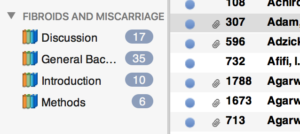Tips for Conquering the Literature
As a new graduate student, I struggled with identifying the most relevant papers, organizing interesting publications, and remembering why I flagged an article as “Super Important!!!” months after I read it. I’ve synthesized a few tips for taming the task:
1. Identify relevant articles:
Pick an approach for keeping up with new publications and tailor your strategy to current needs. My favorite methods include:
- Subscribing to journal table of contents: This is my favorite way to keep up with what’s new in my field. I recommend subscribing to 3-6 journals most relevant to your work. (I can tell you from experience, subscribing to two dozen is too many. You want to manage your subscriptions so you can reasonably follow up and read articles you’re interested in within the week.) If you don’t know which journals to follow, identify those your group typically targets as first choice for a new publication.
- Citation alerts: Creating citation alerts on PubMed or Web of Knowledge will regularly send relevant literature your way. You can create an alert for a general search using keywords and Boolean logic (e.g., [“Leiomyoma” OR “Uterine fibroids”] AND “Preterm Birth”) or set an alert for whenever a single, pivotal article is cited. For general alerts, I refine the search so it returns 15-30 articles a week. Creating an alert that is too broad (e.g., “Pregnancy”) will lead to time wasted digging for the articles you’re truly interested in.
- RSS feeds: Instead of receiving regular emails, you can use RSS feeds to keep up with the literature. Apps like Feedly can collect the same information table of contents email subscriptions would give you and prevent inbox clutter. However, I advise you to stick to one method for tracking new publications, since using multiple platforms is difficult to manage and can lead to redundant work.
2. Choose a reference manager:
Select a reference manager early on and commit to it. Knowing and leveraging the features of your reference manager will make your life much easier. Several good options exist, but my favorite is EndNote because of its ability to find and attach the full-text paper for an imported reference, its filing and annotation capabilities, and its integration with Word. Talk to others about the pros and cons of their favorite reference manager. Once you choose a manager, educate yourself on how to use its features (YouTube is a great place to start). The time you invest here will pay off!
3. Stay organized:
Now that you’re set up with a reference manager and you have new articles coming in on a regular basis, you need a plan for organizing what you read. I recommend setting aside time every week to go through your table of contents and citation alerts and read articles that strike your interest. Once you have imported a citation into your reference manager, file it immediately! (If you do not have time to read right away, create a “Read this Week” file and promise yourself to read and appropriately file those articles by Friday evening.) File articles under a folder that will help you remember why you were interested in the first place. Some of my file names are “Quantitative Methods,” “Reproductive Epidemiology,” “Clinical Applications,” etc. Even better, when you have specific projects underway, file the citation under the project(s) for which you may cite it. EndNote allows you to file one article in numerous places, so file away!
4. Read to write:
While reading new science is fun, most of us do not read as an end unto itself. Instead, we should read with potential applications in mind. Specifically, consider how a publication may demonstrate the need for your current project or how it may frame the context for your work. In EndNote, you can create a “Group Set,” which is simply a family of files. I create a Group Set for each planned manuscript and create files within the set for different parts of a paper (e.g., Introduction, Methods, Discussion). Filing articles by specific sections of future manuscripts will make the writing process much easier. Further, it is helpful to record how you hope to cite the article in your current work. I once had a mentor who advised me when reading for a specific project to write a citation on one side of a notecard and, after reading the publication, draft the sentence in which I would cite it on the other. When it comes time to write, organize the notecards to create a story and the manuscript (or thesis chapter) would write itself. While I wish I could say I diligently carry around a stack of notecards, I have modified his advice to fit with my digital work style. EndNote allows you to create custom fields for citations. It’s infinitely helpful to create a “Main Point” or “Application” field where you can record information you plan to incorporate into your writing.
I have modified his advice to fit with my digital work style. EndNote allows you to create custom fields for citations. It’s infinitely helpful to create a “Main Point” or “Application” field where you can record information you plan to incorporate into your writing.
5. You put in the effort, might as well network!
If you come across a publication you think a colleague will enjoy, don’t hesitate to pass it along. Most people will appreciate a short message to the effect of, “This publication made me think of our conversation about your work on Hippogriff mating patterns.” Such a message shows you paid attention when they were telling you about their work and may bring a helpful publication to their attention. If you’re trying to establish a professional presence online, retweet publications you find particularly interesting. The authors will appreciate the extra press and your enthusiasm for your field will show. These two practices will demonstrate your active engagement with the literature and will help distinguish your voice within your field.






0 Comments